No codding: You don’t have to eat haddock with your chips any more


The fishery, which collapsed in the 1980s as a result of overfishing, has risen above dangerously low levels for the first time after years of reduced fishing and efforts to avoid catching cod in mixed fisheries, the Marine Conservation Society (MCS) said.
Efforts of recent years need to continue in order of for the fishery to head towards the green end of the spectrum.
Advertisement
Hide AdAdvertisement
Hide AdThe signs of improvement have led the MCS, which assesses seafood on a traffic light system and a 1-5 rating where one is the most sustainable, to raise the fishery to an “amber” rating and a level 4 recommendation it should be eaten only very occasionally.
But the conservation group warned cod may never return to its pre-collapse glory days and more effort was needed to boost its populations to healthy levels.
MCS fisheries officer Samuel Stone said: “It’s fantastic to see this fishery finally off the red list. Years of sacrifice and a lot of hard work have led to population increases above dangerously low levels.
“Whilst this is certainly is a milestone for North Sea cod, the job is not done yet.
Advertisement
Hide AdAdvertisement
Hide Ad“Efforts of recent years need to continue in order of for the fishery to head towards the green end of the spectrum.”
He said cod numbers needed to rise and catches should be further reduced down to levels where they are being fished without depleting the population, with all cod stocks in the UK still being fished above that level.
Decades of overfishing which reduced populations and the size and age of cod, along with the warming of the region’s seas have cut the reproductive success of the cod in the North Sea, the MCS said.
With the seas continuing to warm, the slower and lower the recovery may be.
Advertisement
Hide AdAdvertisement
Hide AdThere is also bad news for nine other, smaller, cod fisheries in the North East Atlantic which remain red-listed by the MCS, including those fished from the Irish Sea, Celtic Sea, and West of Scotland.
From being widely caught and landed in UK ports, cod is now the country’s most imported species, with most coming from the northeast Arctic and Iceland where fisheries are doing well but some fish from depleted fisheries finding its way into products.
And a proportion of our imports are fished in Europe and then sent to China to be processed before being imported, making it hard to tell where the cod was originally caught, the conservation group said.
The MCS is urging consumers to ask exactly where their cod is from and businesses to check their supply chains to avoid red listed fish.
Advertisement
Hide AdAdvertisement
Hide AdThe latest update of the FishOnline website which advises consumers on eating sustainable seafood also warns that all wild caught sea bass is now on the “fish to avoid” list as the fishery faces collapse.
Whiting from the Irish Sea has also slipped down into the red list, as the population is severely depleted with high numbers of young fish being caught as bycatch in scampi fisheries.